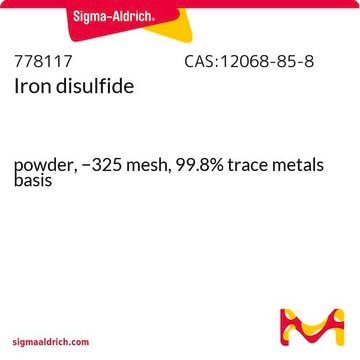450820
Copper(II) sulfide
powder, 99.99% trace metals basis
Synonym(s):
Copper Blue, Copper monosulfide, Cupric sulfide
Sign Into View Organizational & Contract Pricing
All Photos(1)
About This Item
Empirical Formula (Hill Notation):
CuS
CAS Number:
Molecular Weight:
95.61
EC Number:
MDL number:
UNSPSC Code:
12352300
PubChem Substance ID:
NACRES:
NA.23
Recommended Products
Assay
99.99% trace metals basis
form
powder
mp
220 °C (dec.) (lit.)
density
4.6 g/mL at 25 °C (lit.)
SMILES string
S=[Cu]
InChI
1S/Cu.S
InChI key
BWFPGXWASODCHM-UHFFFAOYSA-N
Looking for similar products? Visit Product Comparison Guide
General description
Cu63 NMR, X ray photoelectron spectroscopy,2 copper sulfide CuS was studied in detail.
Packaging
Packaged in ampules
accessory
Product No.
Description
Pricing
Storage Class Code
11 - Combustible Solids
WGK
WGK 3
Flash Point(F)
Not applicable
Flash Point(C)
Not applicable
Personal Protective Equipment
dust mask type N95 (US), Eyeshields, Gloves
Choose from one of the most recent versions:
Certificates of Analysis (COA)
Lot/Batch Number
Don't see the Right Version?
If you require a particular version, you can look up a specific certificate by the Lot or Batch number.
Already Own This Product?
Find documentation for the products that you have recently purchased in the Document Library.
Customers Also Viewed
A {Cu2S}2+ mixed-valent core featuring a Cu-Cu bond.
Stéphane Torelli et al.
Angewandte Chemie (International ed. in English), 49(44), 8249-8252 (2010-09-21)
Min Zhou et al.
Journal of the American Chemical Society, 132(43), 15351-15358 (2010-10-15)
We synthesized and evaluated a novel class of chelator-free [(64)Cu]CuS nanoparticles (NPs) suitable both for PET imaging and as photothermal coupling agents for photothermal ablation. These [(64)Cu]CuS NPs are simple to make, possess excellent stability, and allow robust noninvasive micro-PET
Chunyan Wu et al.
Nanotechnology, 24(4), 045402-045402 (2013-01-10)
Here we report the fabrication of a novel photovoltaic device based on CuS nanotubes (CuSNTs) and indium tin oxide (ITO) Schottky junctions. Large-quantity synthesis of CuSNTs was accomplished via a solution-based sacrificial template method under moderate conditions, while ITO Schottky
Marco Zanella et al.
Chemical communications (Cambridge, England), 47(1), 203-205 (2010-10-05)
Recently (Baranov et al., Nano Lett., 2010, 10, 743) we demonstrated that depletion attraction between semiconductor nanorods in solution can be employed for both their self-assembly and their separation from spherical nanoparticles. Here we show that depletion attraction can be
Wei Zhu et al.
Bioresource technology, 102(4), 3877-3882 (2011-01-05)
The sulfur oxidation activities of four pure thermophilic archaea Acidianus brierleyi (JCM 8954), Metallosphaera sedula (YN 23), Acidianus manzaensis (YN 25) and Sulfolobus metallicus (YN 24) and their mixture in bioleaching chalcopyrite were compared. Meanwhile, the relevant surface sulfur speciation
Our team of scientists has experience in all areas of research including Life Science, Material Science, Chemical Synthesis, Chromatography, Analytical and many others.
Contact Technical Service











